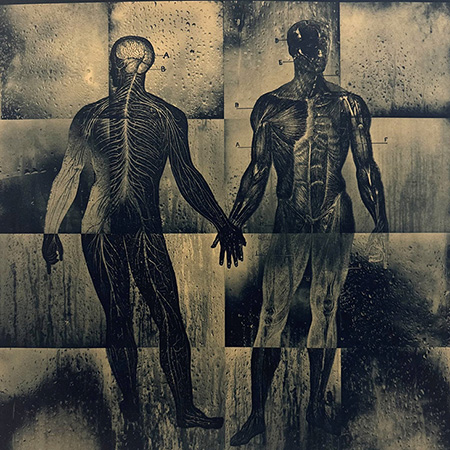
Continuing through May 22, 2023
In this ten-year survey, conceptual artist and photographer Ted Kincaid presents his ongoing investigation of the natural beauty found in the elements earth, sea, and sky — a beauty he sees as inextricably bound to the male form. His work is as much a retrieval of the notion of beauty in art going back to ancient Greek sculpture — think Polyclitus, Praxiteles, Myron — as it is a political stance driven by present-day struggles within the LGBTQ+ community. Central to this body of work is the notion that queer identity must be understood as such, and not as a set of acts or series of behavioral modes that objectify or demean it.
Kincaid often captures an image which he proceeds to alter and thereby manufacture a new digital composition. He draws on erotic photography from the late 19th and early 20th centuries, soft-focus Pictorialist work from the same period, and earlier 19th century cyanotypes and sepia toned images. A critical reading of the work of canonic American artists and writers like Thomas Eakins, Herman Melville, and Walt Whitman has inspired Kincaid to comport himself as a fellow traveler tied to the group.
At a time when the purpose of photography was a subject of intense debate, fin de siécle Pictorialists sought to create images rather than settling on one-to-one representations of reality. Beyond their signature soft focus, these photographers expanded their medium’s use of textures and its range of colors. These visual effects were a direct result of the manipulation of their surfaces, and were intended to present atmospheric images that communicated a range of moods and emotions. What they achieved through analog means Kincaid has achieved here through current digital technology, and it has inspired fresh ways to address homoeroticism, nature, and man’s conflict with nature. For Kincaid, these issues engage metaphorically with current struggles against social and political currents that misunderstand or misrepresent alternative identities.
None of the images that feature male nudity register as pornographic. Rather, they entice via visual pleasure and curiosity. In “The Wrestlers 2 (for Thomas Eakins)” the artist uses a tondo format to frame a black and white composition of two struggling nude bodies. In another series titled “Academic Nudes,” the bodies are sometimes cropped and designed to look like ancient marble sculptures of torsos or seated figures.
Arranged together on one wall are pieces from the series “An Inspiration to Enfold All,” in which the figures are enveloped in bright light. Two works feature reclining figures, while one bathed in a brilliant cyan blue sits facing out at the viewer. Each of these meditate on classical Greek philosophy, whose practitioners represent an early form of queer identity active during a foundational period of Western thought and culture.
Hanging alongside “An Inspiration” is “The Difficulty of Representation,” a cloudy image with an atmosphere engulfed in what reads as smoke or rain. It’s reminiscent of English painter J.M.W. Turner, whose iconic “Rain, Steam, and Speed — The Great Western Railway” is an apt predecessor on a purely formal level. Kincaid’s interest, however, is philosophical, a rumination on images and how they sometimes prove inadequate when it comes to conveying reality.
Dense and blue, the beautiful “Trinity” fills 60 by 80 inches with the wonders of nature. Plants, trees, and flora in general populate an image composed on a grid format with twelve squares in three rows of four. The piece suggests that Kincaid sees queer identity as something as natural and verdant as nature itself, seeing as how he has positioned the piece in the flow of an exhibition with so many erotic nude bodies.
For a touch of Melville’s “Billy Budd” or “Moby Dick,” the motif of sailors and sailing ships makes an appearance in “Not For Another Hour, But This Hour 4,” with the artist himself included in the image. A figure to the left, Kincaid, struggles to pull a boat to shore against the waves, while a massive ship is pictured in the background. Versions in several different colors are on view. They are romantic images of man contending with the elements, a sense of adventure and pride in full view.
These images are as layered with references and ideas as they are dense with texture and depth. The subject matter makes this an adults-only show, but, if elements of the political far right continue to gain ground in the state of Texas, adults might also be deprived the pleasures of such shows in a not-too-distant future.
